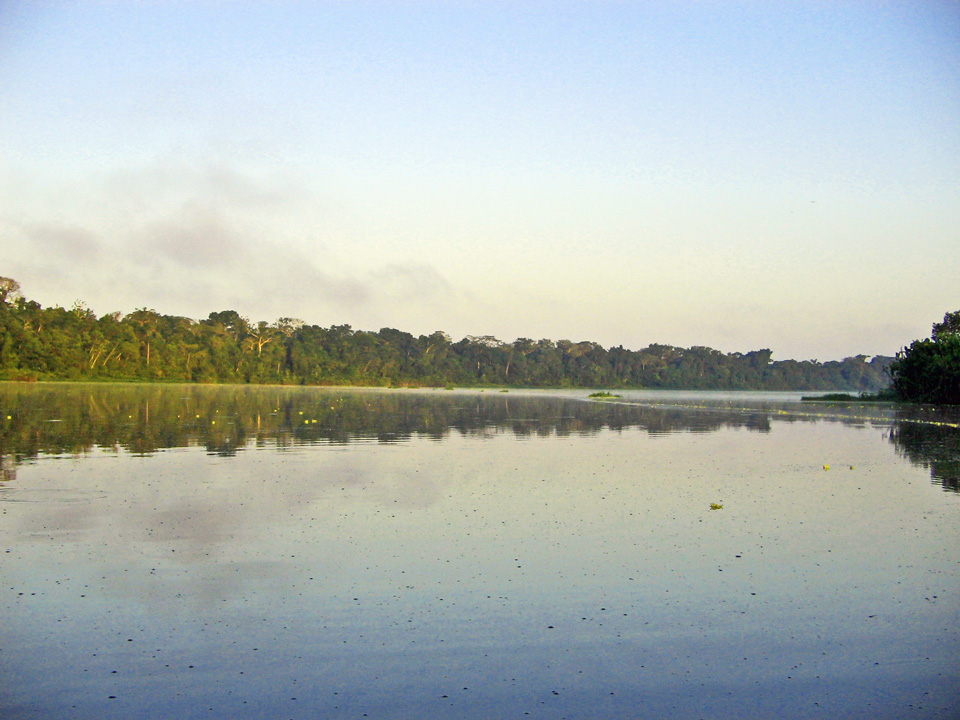The Amazon (part 2)
http://www.jamesborrell.com/wp-content/uploads/2012/12/IMG_09_Sunlight-through-the-canopy-2web.jpg
Continued from part 1..
Catching Caiman by night wasn’t our sole reason for travelling to the largest rainforest on earth. We were here to take a snapshot of this regions biodiversity. The papers and reports from this and years of similar work would eventually show numbers and trends. Hopefully rising, but all to often falling. The papers and reports would eventually be turned into policy, politics and with a bit of luck, conservation. That is the big picture. However, the reality of boots in the mud conservation is about as far removed from an office or laboratory, as it’s possible to be.
At dawn we would scoff down porridge eking out our tiny ration of jam before setting off into the forest. Trudging through the leaf litter and muddy pools while mosquitos dive-bombed any exposed patch of skin. Adolfo would lead the way, naturally. Oversized wellington boots, baggy blue shirt and a machete over his shoulder completed the picture. He had a far better chance than us of spotting snakes, dancing through the undergrowth and over fallen trees with agility that belied his age.
Occasionally he would stop as if to taste the air, pointing out plants with medicinal properties, or stooping to clear the way with a swipe of his machete. Undeterred, we jotted down notes, tallying up the number of Capuchins or Squirrel Monkeys darting along branches, or thumbing through our species guides in confusion.
Our eyes searched the skyward canopy as we shuffle along trails, tripping on tree roots in the stifling heat of the understory. A guttural roar rings out above us, quickly joined by a chorus of others, so loud they shake the pit of your stomach and you stand there dumbstruck in awe. “Alouatta…” Carlos says buoyantly, the rest of his sentence drowned out by renewed roars from above. Howler monkeys, the loudest land mammal, and a good sign that the forest is healthy.
Periodically we would rest. Those inexperienced and ill versed in the ways of the Amazon like myself, might unknowingly lean against a Tangarana tree. Tangarana is the Cocama Indian name for this certain type of tree, but crucially, also the name of the particularly aggressive ants that nest inside and fiercely protect it – in this case from a careless Englishman. For something as small as an ant, the sting can only be described as impressive.
Over time we grew used to life in the rainforest. Occupying our days with the building of reptile traps, surveying aquatic birds and casting nets to survey the lakes fish, only once bringing up a less than impressed four-meter anaconda by accident, sending us paddling for cover. Sights and sounds became familiar too. Occasionally we would hear a deadfall. An ominous roll of thunder as unseen somewhere in the forest a trees life comes to an end as it crashes to the ground. Or the squawk’s of squadrons of Blue and Yellow Macaws signalling dusk and dusk as they return to their roosts.
Bio
http://www.jamesborrell.com/wp-content/uploads/2012/05/IMG_0727small-w960-h600.jpgJames is a conservation biologist with a passion of exploration and adventure. He is a keen supporter of Citizen Science, and speaks regularly in schools to inspire young people. In the summer of 2011 James spent a month living and working in the Pacaya-Samiria National Reserve, Peru.
http://www.jamesborrell.com/wp-content/uploads/2012/05/IMG_5961galleryedit-w960-h600.jpg
http://www.jamesborrell.com/wp-content/uploads/2012/05/IMG_5431SMALL-w960-h600.jpg
http://www.jamesborrell.com/wp-content/uploads/2012/05/IMG_0492B_edited-1-w960-h600.jpg
http://www.jamesborrell.com/wp-content/uploads/2011/11/386846_279615265414185_162265227149190_819164_468480338_n-w960-h600.jpgMany of the local people had once been hunters, regaling us with stories of their fearsome face-to-face encounters with the Jaguar. But times have changed; indigenous peoples across the whole region are beginning to work hand in hand with conservation organisations to bring about a sustainable future for the Amazon.
As our oldest and most experienced guide, I was immensely fond of Adolfo. At 64 this part of the world had changed immeasurably in his lifetime and as we sat resting on the leaf litter one day, particularly disheartened at a lack of any sightings, I endeavored to ask him what he remembers of the forest from his childhood. Language was a barrier between us, my Spanish languishing terribly at school along with French and German, so we rarely understood each other save for a shared unspoken passion for the forest. He pondered for a moment, looking first around at the trees towering around us and then at me, “más pescado…” “more fish” Dan mumbled beside me, as I picked up on the few words I could understand. “más primates, más aves…” He shook his head, there had been an abundance of everything.
At the same time though, Adolfo was filled with hope that a ramshackle group of explorers would come all this way to try and help and with pride at the importance with which we regarded his home. Many of the local people here had once been hunters, regaling us with stories of their fearsome face-to-face encounters with the Jaguar. But times have changed; indigenous peoples across the whole region are beginning to work hand in hand with conservation organisations to bring about a sustainable future for the Amazon. Logging is slowing, poaching is in decline, new battles emerge with land ownership and mining, but things are looking up.
The Amazon rainforest is a hostile and unforgiving place, especially for those from far off countries. Anyone who ventures to work in such a diverse environment is bound to encounter a healthy dose of adventure, but this is not the most valuable reward for enduring the inevitable hardships. No, the true reward for conservation in the Amazon is this; It’s working.
This article was originally commissioned and published by the folks over at Outer Edge Magazine, more on writing here.
Share:


